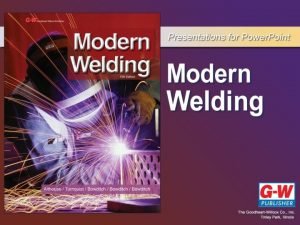Optimal Energy Delivery Weld Controller Gurunath KedarDongarkar Tejaswini

- Slides: 1

Optimal Energy Delivery Weld Controller Gurunath Kedar-Dongarkar Tejaswini Badawe Premchandra Sharath. Kumar Dr. Manohar Das Dr. Vernon Fernandez Gerry Grzadzinsky Objectives Ø Ø Additional Features of the OEDC Development of a microcontroller based Optimal Energy Controller (OEDC) for the Resistance Spot Welding process. Ø Continuous measurement of the dynamic resistance Dynamic resistance signature is continuously monitored Development of a PC based user interface requiring entry of just two input variables, namely, types of materials and stack thickness. OEDC will then automatically select the optimal weld parameter settings. Ø Estimation of weld nugget size and weld strength The weld strength and nugget size are estimated from the dynamic resistance signature obtained during the weld Development and implementation of an online nugget size estimation algorithm, and Ø Statistical Process Control (SPC) The estimated values of weld nugget size, weld strength and frequency of expulsion are fed to a statistical process control algorithm which analyzes the data and initiates corrective actions to the weld controller, as necessary. Implementation of a statistical process control algorithm for OEDC. Introduction Current Status Welding is a process by which two materials are permanently joined together. ØA prototype OEDC system has been designed and built. Ø In Resistance Spot Welding process, a large current passes through two electrodes. ØA prototype GUI has been developed. ØThe initial test results are very promising. OEDC seems to be capable of delivering large nuggets without expulsion and they consume minimum amount of energy. Ø As a result, Joule heat is generated due to the resistance of the material resulting in melting and fusion of the two materials. Ø 1. 2. 3. 4. Factors affecting the Welding Process: Micro-parameters: ~ Metal Microstructures ~ Progressive Degeneration of Electrodes ~ Variations in surface conditions 5. 2. ØPreliminary weld settings for 2 -T and 3 -T mild steel stacks with various types of coatings used in the automotive industry have been developed. Macro- parameters: ~ Voltage ~ Resistance ~ Current ~ Force ~ displacement (indentation) Features of the OEDC Advantages Ø OEDC uses a built-in microcontroller system that offers high reliability and flexibility. Ø Estimation of resistance of the work-piece material This is done in real time from measured values of tip voltage and current. Ø OEDC delivers a high nugget diameter to energy ratio for a given cap diameter and stack thickness. Ø Detection of the presence and extent of shunting At the beginning of each weld, the presence of shunting is detected from measured resistance values and appropriate corrective action is initiated by the OEDC. Ø Computation of heat energy, welding current, force and welding time OEDC incorporates an intelligent algorithm to compute the optimal heat energy, force and weld time for given materials and stack thicknesses. Ø OEDC is adaptable to both AC and MFDC weld controllers. Cost Savings Ø OEDC offers significant savings in energy cost. Nugget Ø Additional cost savings result from: ü Reduction of welding slag damage to machines ü Increased productivity due to lower number of welding cycles

